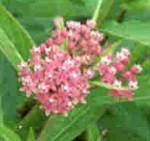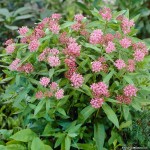 Swamp milkweed is a herbaceous perennial native to North America where it grows in moist to wet soils including swamps, ditches, and the edges of ponds, lakes, and streams. It is a member of the dogbane family (Apocynaceae) that also includes bluestar (Amsonia), periwinkle (Vinca), and oleander (Nerium). The plants emerge in late spring from a fleshy white taproot and form clumps of branched stems with pointed narrow lanceolate leaves three to six inches long . The small fragrant flowers are pink to mauve (sometimes white), and ¼ inch across. They are carried in tight flat terminal umbels two to four inches across in summer and give way to four to five inch long seed pods. The brown seeds are flat and have long silvery white silky hairs to facilitate wind dissemination. The flowers are an important source of nectar for butterflies and the leaves are a food source for larval Monarch butterflies. The sap contains toxic chemicals that is taken up by the larvae, giving them an unpleasant taste that discourages predation by other insects and animals. Flowers are attractive n the vase and pods are valuable for dried arrangements. Transplants is difficult because of the long taproot. The generic name, Asclepias, is the name of the Greek god of medicine. The specific epithet, incarnata, is from the Latin word, incarnatus, meaning fleshcolored.
Swamp milkweed is a herbaceous perennial native to North America where it grows in moist to wet soils including swamps, ditches, and the edges of ponds, lakes, and streams. It is a member of the dogbane family (Apocynaceae) that also includes bluestar (Amsonia), periwinkle (Vinca), and oleander (Nerium). The plants emerge in late spring from a fleshy white taproot and form clumps of branched stems with pointed narrow lanceolate leaves three to six inches long . The small fragrant flowers are pink to mauve (sometimes white), and ¼ inch across. They are carried in tight flat terminal umbels two to four inches across in summer and give way to four to five inch long seed pods. The brown seeds are flat and have long silvery white silky hairs to facilitate wind dissemination. The flowers are an important source of nectar for butterflies and the leaves are a food source for larval Monarch butterflies. The sap contains toxic chemicals that is taken up by the larvae, giving them an unpleasant taste that discourages predation by other insects and animals. Flowers are attractive n the vase and pods are valuable for dried arrangements. Transplants is difficult because of the long taproot. The generic name, Asclepias, is the name of the Greek god of medicine. The specific epithet, incarnata, is from the Latin word, incarnatus, meaning fleshcolored.
Type: Herbaceous perennial
Bloom: Small pink to mauve flowers, sometimes white, carried in tight terminal umbels in summer
Size: 3-5’ H 2-3’ W
Light: Full sun
Soil: Average, moist to wet but tolerates well-drained soil
Hardiness: Zones 3-6
Care: Low maintenance
Pests and Diseases: None of significance
Propagation: Root cuttings in fall, fresh seed planted in fall
Companion Plants: Beebalm (Monarda), meadowsweet (Filipendula purpurea), Euphorbia palustris, monkey flower (Mimulus luteus), gooseneck loosestrife